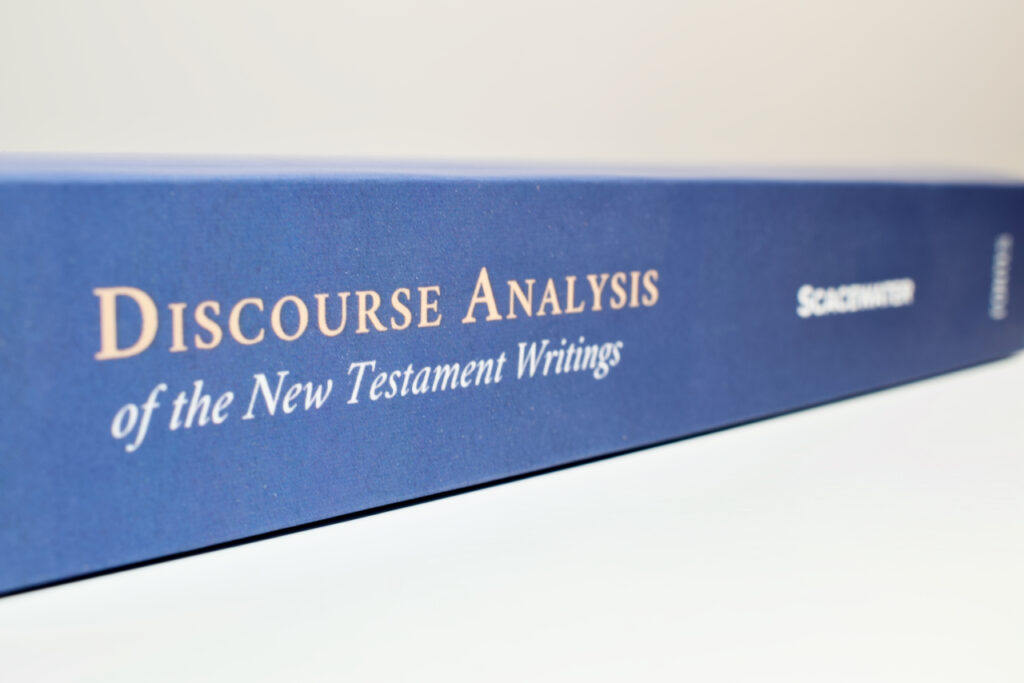A Book Review
Everyone is a discourse analyst. Everyone, consciously or unconsciously, processes texts and speech to identify boundaries, prominence, and cohesion. Discourse Analysis of the New Testament Writings, edited by Todd A. Scacewater, is a conscious attempt to enlist an array of competent contributors to process the texts of the New Testament in this manner of going beyond the sentence level. And, to my knowledge, it is the first book to provide a discourse analysis (DA) of every New Testament book in a single volume.
If you are unfamiliar with DA, Scacewater’s excellent introduction describes the discipline in terms of three primary concerns:
(1) language beyond the level of the sentence
(2) language use
(3) the social and interpersonal aspects of communication (2–3).
I’m convinced that discourse analysis is a fruitful tool for both narrative and non-narrative material. But it is important to understand there is no set way to practice DA. And the practitioners in this edited volume present their own unique ways. Readers may find it slightly bewildering to try and grasp each contributor’s methodology and terminology, but most of the contributors follow a similar approach of assessing macrostructure, microstructures, and prominence. Practically, this means each contributor identifies their book’s topic, divisions, and key thrust(s). And, if DA can deliver such goods, the exegetical payoff is straightforward. It would be irresponsible to preach a passage from a book of the Bible without understanding that book’s communicative thrust and structure. Discourse Analysis of the New Testament gives the reader this careful analysis.

The diversity of approaches presented in this book, to my thinking, may also be a (small) weakness. This is not any inherent fault of the book, but rather, a reflection of the discipline’s current state. It lacks uniformity and standardization. On the one hand, the diversity of approaches gives the reader many ways to see DA in action. But, on the other hand, the non-specialist may struggle to see how these approaches differ. I didn’t feel the treatment of Hebrews by Cynthia Long Westfall, a practitioner of Systemic Functional Linguistics (SFL), was all that different from Todd A. Scacewater’s chapter on Colossians, practically speaking. So, short of consensus, I would welcome an organizing principle that easily identifies the adopted approach and its accompanying ramifications to help the reader understand where each chapter aligns.
I’ll comment briefly on those who seemed to me to differ the most from the majority. Jenny Read-Heimerdinger considers textual criticism in her study of Acts by proposing our efforts are better directed towards a text as received (in this case, Codex Bezae) rather than a text as produced (an eclectic critical text). Frederick J. Long takes a different tack by applying Inductive Bible Study and its accompanying labeling system of “Major Structural Relationships” to 2 Corinthians. Daniel Patte’s DA of 1 Thessalonians differs from the other chapters by distinguishing between two textual levels: the dialogical level (“dialogue proper”) and the warranting level. But when understood as the more common distinction drawn between mainline material and offline or supporting material, the difference in terms seems to be insignificant. The difference is his analysis almost entirely centers on distinguishing between these two levels. Mike Aubrey, in his analysis of 2 Thessalonians, breaks from the group by admitting: “I consider sentence grammar and discourse grammar as the same grammar” (443). This serves as an important reminder that discourse analysis need not be divorced from syntactical analysis. The reader will find that methodology differs but each chapter bears useful insights resulting from careful research. And each contributor modestly recognizes their conclusions are not the final say, but only an attempt to draw conclusions others can learn from and assess.
Discourse Analysis of the New Testament Writings is a welcome addition to our collective exegetical arsenal. Finally, we have a book that contains a DA of every New Testament book instead of a book that just discusses applying DA to the New Testament. The Bible warrants our most rigorous linguistic analyses. Bible introductions and commentaries are useful in their own right, but few take advantage of up-to-date linguistic tools to shed new light on structure and prominence. I would encourage anyone preaching or teaching on a New Testament text to read the applicable chapter in this book before doing so. Nowhere else will you find such a host of qualified analysts (many who have also published books, chapters, or articles on their assigned book) presenting well-reasoned linguistic arguments on how to understand each New Testament book as a whole. This labor is not designed to revolutionize our understanding of a text. We’ve been analyzing these texts for centuries. But it can give us confidence in our exegetical decisions while forcing us to go beyond the sentence level in our study. Now, if only Fontes Press would undertake the daunting task of publishing Discourse Analysis of the Old Testament Writings.
Special thanks to Fontes Press for providing me with a free review copy of this book. This did not affect my thoughts in any way so far as I’m aware. I also appreciate my friend, Joey McCollum, kindly offering suggested improvements on a draft of this review.
0 Comments